*NURSING > QUESTIONS & ANSWERS > 2022 AAFP Questions and answers, 99% approved pass rate. (All)
2022 AAFP Questions and answers, 99% approved pass rate.
Document Content and Description Below
2022 AAFP Questions and answers, 99% approved pass rate. A 4-week-old white male is brought to your office with a 2-week history of increasing dyspnea,cough, and poor feeding. The child appears ... nontoxic and is afebrile. On examination you noteconjunctivitis, and a chest examination reveals tachypnea and crackles. A chest film shows hyperinflation and diffuse interstitial infiltrates and a WBC count reveals eosinophilia.What is the most likely etiologic agent? A. Staphylococcus species B. Chlamydia trachomatis C. Respiratory syncytial virus D. Parainfluenza virus - ✔✔B. Chlamydia trachomatis Chlamydial pneumonia is usually seen in infants 3-16 weeks of age, and these patients frequently havebeen sick for several weeks. The infant appears nontoxic and is afebrile, but is tachypneic with a prominentcough. The physical examination will reveal diffuse crackles with few wheezes, and conjunctivitis ispresent in about 50% of cases. A chest film will show hyperinflation and diffuse interstitial or patchyinfiltrates. A 52-year-old male presents with moderate symptoms of prostatism. A prostate examination is normal. His post-void residual volume is 90 mL. His PSA level is 0.75 ng/mL (N 0.0-4.0). He says his nocturia has become troublesome and you decide to initiate therapy.This patient does NOT meet the criteria for use of which one of the following? A. Doxazosin (Cardura) B. Finasteride (Proscar) C. Tadalafil (Cialis) D. Tamsulosin (Flomax) E. Silodosin (Rapaflo) - ✔✔B. Finasteride (Proscar) Pharmacologic options for benign prostatic hyperplasia and lower urinary tract symptoms include an α-adrenergic blocker, a 5-α-reductase inhibitor (if there is evidence of prostatic enlargement or a PSA level >1.5 ng/mL), a phosphodiesterase-5 inhibitor, or antimuscarinic therapy. The first three have proven efficacy as monotherapies. Finasteride is a 5-α-reductase inhibitor A factory worker sustains a forced flexion injury of the distal interphalangeal (DIP) joint,resulting in a small bone fragment at the dorsal surface of the proximal distal phalanx (malletfracture). Which one of the following is the most appropriate management strategy? A. Buddy taping and early range of motion B. Splinting the DIP joint in extension C. Splinting the DIP joint in flexion D. Referral for surgical repair - ✔✔B. Splinting the DIP joint in extension The recommended treatment for a mallet fracture is splinting the distal interphalangeal (DIP) joint inextension (SOR B). The usual duration of splinting is 8 weeks. It is important that extension be maintained throughout the duration of treatment because flexion can affect healing and prolong the time needed for treatment. If the finger fracture involves >30% of the intra-articular surface, referral to a hand ororthopedic surgeon can be considered. However, conservative therapy appears to have outcomes similarto those of surgical treatment and therefore is generally preferred. Which one of the following drugs is NOT effective for maintenance therapy in bipolar disorders? (check one) A. Haloperidol B. Lamotrigine (Lamictal) C. Lithium D. Quetiapine (Seroquel) E. Valproate sodium (Depacon) - ✔✔A. Haloperidol Lithium, valproate, lamotrigine, and some antipsychotics (including quetiapine) are effective treatmentsfor both acute depression and maintenance therapy of bipolar disorders. Haloperidol is an effectivetreatment for acute mania in bipolar disorders, but not for maintenance therapy or acute depression. Acne appearing at which one of the following ages should prompt detailed endocrine laboratory testing for possible underlying systemic disease? A. 3 weeks B. 7 months C. 5 years D. 9 years E. 13 years - ✔✔C. 5 years As many as 20% of newborns will be affected by neonatal acne, usually in the form of pustules confined to the cheeks, chin, eyelids, and forehead. This is typically mild, self-limited, and best managed by reassuring the parents. Acne can also appear in infants, typically males 6-12 months of age, and is also usually self-limited and not associated with underlying endocrine pathology in the absence of any other findings suggesting hormonal abnormalities such as clitoromegaly, breast or testicular development, pubic hair growth, hirsutism, or a growth abnormality consistent with increased muscle development. Acne appearing during mid-childhood is rare and, if present, warrants referral for extensive laboratory testing to identify an underlying endocrine abnormality. Preadolescents and adolescents are very likely to develop acne as a result of normal ovarian/testicular development. In the absence of other findings to suggest an endocrine problem, developing an effective treatment regimen is most appropriate for these individuals. Patients being treated with amiodarone (Cordarone) should be monitored periodically with serumlevels of A. cortisol B. creatine phosphokinase C. creatine D. LDH E. TSH - ✔✔E. TSH Patients on amiodarone can develop either hyperthyroidism or hypothyroidism. It is recommended that apatient on amiodarone have baseline thyroid function tests (free T4, TSH) with follow-up testing every 6months to monitor for these conditions. Hyperadrenalism and hypoadrenalism are not associated withamiodarone treatment. A mother brings her 2-year-old daughter to your office because the child is not using her leftarm. Earlier in the day the mother left the toddler under the supervision of her 12-year-old sisterwhile she went to the store. When she returned the toddler was playing with toys using only herright arm, and was holding the left arm slightly pronated, flexed, and close to her body. Theolder daughter was unaware of any injury to the girl's arm, and the child does not seemdistressed or traumatized. Physical examination of the child's clavicle, shoulder, wrist, and hand do not elicit any signs ofpain or change in function. She does seem to have some tenderness near the lateral elbow andresists your attempts to examine that area. There is no ecchymosis, swelling, or deformity of theelbow.Which one of the following would be most appropriate at this point? A. Plain radiographs of the affected elbow B. Ultrasonography of the affected elbow C. Evaluation by an orthopedic surgeon within 24 hours D. Attempted reduction of the subluxed radial head E. Placement in a splint and follow-up in the office if there is no improvement in the next 1-2 weeks - ✔✔D. Attempted reduction of the subluxed radial head Radial head subluxation, or nursemaid's elbow, is the most common orthopedic condition of the elbow inchildren 1-4 years of age, although it can be encountered before 1 year of age and in children as old as9 years of age. The mechanism of injury is partial displacement of the radial head when the child's armundergoes axial traction while in a pronated and fully extended position. The classic history includes acaregiver picking up (or pulling) a toddler by the arm. In half of all cases, however, no inciting event isrecalled. As long as there are no outward signs of fracture or abuse it is considered safe and appropriate to attemptreduction of the radial head before moving on to imaging studies. With the child's elbow in 90° of flexion,the hand is fully supinated by the examiner and the elbow is then brought into full flexion. Usually thechild will begin to use the affected arm again within a couple of minutes. If ecchymosis, significantswelling, or pain away from the joint is present, or if symptoms do not improve after attempts at reduction,then a plain radiograph is recommended. A 12-year-old male uses a short-acting bronchodilator three times per week to control hisasthma. Lately he has been waking up about twice a week because of his symptoms.Which one of the following medications would be most appropriate? A. Inhaled medium-dose corticosteroids B. A scheduled short-acting bronchodilator C. A scheduled long-acting bronchodilator D. A leukotriene inhibitor E. Ordering a free T 4 - ✔✔A. Inhaled medium-dose corticosteroids This patient has moderate persistent asthma. Although many parents are concerned about corticosteroiduse in children with open growth plates, inhaled corticosteroids have not been proven to prematurely closegrowth plates and are the most effective treatment with the least side effects. Scheduled use of ashort-acting bronchodilator has been shown to cause tachyphylaxis, and is not recommended. The sameis true for long-acting bronchodilators. Leukotriene use may be beneficial, but compared to those usinginhaled corticosteroids, patients using leukotrienes are 65% more likely to have an exacerbation requiringsystemic corticosteroids. Which one of the following is the most appropriate first-line therapy for primary dysmenorrhea? A. Combined monophasic oral contraceptives B. Combined multiphasic oral contraceptives C. Subdermal etonogestrel (Nexplanon) D. Intramuscular medroxyprogesterone (Depo-Provera) E. NSAIDs - ✔✔E. NSAIDs The first-line treatment for primary dysmenorrhea should be NSAIDs (SOR A). They should be started at the onset of menses and continued for the first 1-2 days of the menstrual cycle. Combined oral contraceptives may be effective for primary dysmenorrhea, but there is a lack of high-quality randomized, controlled trials demonstrating pain improvement (SOR B). They may be a good choice if the patient also desires contraception. Although combined oral contraceptives and intramuscular and subcutaneous progestin-only contraceptives are effective treatments for dysmenorrhea caused by endometriosis, they are not first-line therapy for primary dysmenorrhea. While performing a routine physical examination on a 42-year-old female you discover anapparent nodule in the left lobe of the thyroid measuring approximately 1 cm in diameter, whichis confirmed on ultrasonography. The most appropriate next step in the evaluation of this finding is a A. serum calcitonin level B. serum free T3 level C. serum TSH level D. serum thyroglobulin leve E. radionuclide thyroid scan - ✔✔C. serum TSH level Thyroid nodules >1 cm that are discovered incidentally on examination or imaging studies merit further evaluation. Nodules <1 cm should also be fully evaluated when found in patients with a family history of thyroid cancer, a personal history of head and neck irradiation, or a finding of cervical node enlargement. Reasonable first steps include measurement of TSH or ultrasound examination. The American Thyroid Association's guidelines recommend that TSH be the initial evaluation (SOR A) and that this be followed by a radionuclide thyroid scan if results are abnormal. Diagnostic ultrasonography is recommended for all patients with a suspected thyroid nodule, a nodular goiter, or a nodule found incidentally on another imaging study (SOR A). Routine measurement of serum thyroglobulin or calcitoninlevels is not currently recommended. A 10-year-old male has an 8-mm induration 2 days after a tuberculin skin test. He shares a bedroom with his 18-year-old brother who was recently diagnosed with tuberculosis. There are no other historical or physical examination findings to suggest active tuberculosis infection and a chest radiograph is normal.Which one of the following would be most appropriate at this point? A. toring with annual tuberculin skin testing B. Observation and repeat tuberculin skin testing in 3 weeks C. Rifampin (Rifadin) daily for 4 months D. Isoniazid daily for 9 months E. Once-weekly isoniazid and rifampin for 3 months - ✔✔D. Isoniazid daily for 9 months This patient's close contact with a person known to be infected with tuberculosis (TB) places him at risk for infection, so screening for TB is indicated. For this patient, testing with either a tuberculin skin test or an interferon-gamma release assay is appropriate. Based on CDC guidelines an induration 5 mm at 48-72 hours following an intradermal injection of tuberculin is a positive test in individuals who have been in recent contact with a person with infectious TB, those with radiographic evidence of prior TB, HIV-infected persons, and immunosuppressed patients. For other individuals at increased risk for TB, the threshold for a positive test is an induration 10 mm at 48-72 hours. For those with no known risks for TB infection, the induration must exceed 15 mm in size to be considered positive. Once positive, there is no indication for additional skin tests. A positive screening test along with a review of systems, a physical examination, and a chest radiograph that do not show evidence of active infection confirms the diagnosis of latent TB. For children age 2-11 years, treatment with isoniazid, 10-20 mg/kg daily or 20-40 mg/kg twice weekly for 9 months, is the preferred and most efficacious treatment regimen. The shorter 6-month treatment course is considered an acceptable option for adults, but it is not recommended for children. The use of rifampin alone or in combination with isoniazid is also an acceptable option for adults but not for children under the age of 12. A 62-year-old female with diabetes mellitus presents to your office with left lower quadrant pain and guarding. She has a previous history of a shellfish allergy that caused hives and swelling.Further evaluation of this patient should include which one of the following? A. Ultrasonography of the abdomen B. CT of the abdomen and pelvis with oral and intravenous (IV) contrast C. Oral corticosteroids and antihistamines, then CT of the abdomen and pelvis with oral and IV contrast D. Intravenous corticosteroids and antihistamines, then CT of the abdomen and pelvis with oral and IV contrast E. Laparotomy - ✔✔B. CT of the abdomen and pelvis with oral and intravenous (IV) contrast Evaluation of this patient should include CT of the abdomen and pelvis with oral and intravenous (IV) contrast. There is no reason to inquire about shellfish allergies prior to CT with IV contrast, because premedication is not needed. There is no correlation between shellfish allergies and allergic reactions to contrast. Patients with moderately severe to severe reactions to IV contrast in the past would need pretreatment with corticosteroids. A 45-year-old female who works as a house cleaner presents with left shoulder pain. On examination she has pain and relative weakness when pushing toward the midline against resistance while the shoulder is adducted and the elbow is bent to 90°. With the elbow still at 90° she is unable to keep her left hand away from her body when you position her hand behind her back.This presentation is most consistent with an injury of which one of the following tendons? A. Deltoid B. Infraspinatus C. Subscapularis D. Supraspinatus E. Teres minor - ✔✔C. Subscapularis This patient's pain and weakness while pushing against resistance reveals weakness on internal rotation of the shoulder, which suggests a possible tear of the subscapularis tendon. The inability to keep her hand away from her body when it is placed behind her back describes a positive internal lag test, also suggesting involvement of the subscapularis tendon. The infraspinatus and teres minor are involved in external rotation rather than internal rotation. The supraspinatus and deltoid are involved in abduction of the shoulder. An 8-year-old male is brought to your office because of acute lower abdominal pain. He is not constipated and has never had abdominal surgery. You suspect acute appendicitis.Which one of the following would be most appropriate at this point? A. Plain radiography B. Ultrasonography C. CT without contrast D. CT with contrast E. MRI - ✔✔B. Ultrasonography Ultrasonography is recommended as the first imaging modality to evaluate acute abdominal pain in children. It avoids radiation exposure and is useful for detecting many causes of abdominal pain, including appendicitis. After ultrasonography, CT or MRI can be used if necessary to diagnose appendicitis. Abdominal radiography is helpful in patients with constipation, possible bowel obstruction, or a history of previous abdominal surgery. The American Academy of Pediatrics Choosing Wisely recommendation on the evaluation of abdominal pain states that CT is not always necessary. The American College of Surgeons Choosing Wisely recommendation on the evaluation of suspected appendicitis in children says that CT should be avoided until after ultrasonography has been considered as an option. You see a patient with a serum sodium level of 122 mEq/L (N 135-145) and a serum osmolality of 255 mOsm/kg H2O (N 280-295). Which one of the following would best correlate with a diagnosis of syndrome of inappropriate antidiuresis? A. A fractional excretion of sodium below 1% B. Elevated urine osmolality C. Elevated serum glucose D. Elevated BUN E. Low plasma arginine vasopressin - ✔✔B. Elevated urine osmolality The syndrome of inappropriate antidiuresis (SIAD, formerly SIADH) is related to a variety of pulmonary and central nervous system disorders in which hyponatremia and hypo-osmolality are paradoxically associated with an inappropriately concentrated urine. Most cases are associated with increased levels of the antidiuretic hormone arginine vasopressin (AVP). Making a diagnosis of SIAD requires that the patient be euvolemic and has not taken diuretics within the past 24-48 hours, and the urine osmolality must be high in conjunction with both low serum sodium and low osmolality. The BUN should be normal or low and the fractional excretion of sodium >1%. Fluid restriction (<800 cc/24 hrs) over several days will correct the hyponatremia/hypo-osmolality, but definitive treatment requires eliminating the underlying cause, if possible. In the case of severe, acute hyponatremia with symptoms such as confusion, obtundation, or seizures, hypertonic (3%) saline can be slowly infused intravenously but might have dangerous neurologic side effects. Elevated serum glucose levels may cause a factitious hyponatremia, but not SIAD. A 45-year-old African-American male returns to your clinic to evaluate his progress after 6 months of dedicated adherence to a diet and exercise plan you prescribed to manage his blood pressure. His blood pressure today is 148/96 mm Hg. He is not overweight and he does not have other known medical conditions or drug allergies.Which one of the following would be the most appropriate initial antihypertensive treatment option for this patient? A. Chlorthalidone B. Hydralazine C. Lisinopril (Prinivil, Zestril) D. Losartan (Cozaar) E. Metoprolol - ✔✔A. Chlorthalidone Lifestyle modifications addressing diet, physical activity, and weight are important in the treatment of hypertension, particularly for African-American and Hispanic patients. When antihypertensive drugs are also required, the best options may vary according to the racial and ethnic background of the patient. The presence or absence of comorbid conditions is also important to consider. For African-Americans, thiazide diuretics and calcium channel blockers, both as monotherapy and as a component in multidrug regimens, have been shown to be more effective in lowering blood pressure than ACE inhibitors, angiotensin II receptor blockers, or β-blockers, and should be considered as first-line options over the other classes of antihypertensive drugs unless a comorbid condition is present that would be better addressed with a different class of drugs. Racial or ethnic background should not be the basis for the exclusion of any drug class when multidrug regimens are required to reach treatment goals. An 85-year-old female with metastatic breast cancer requests hospice care. She has type 2 diabetes mellitus, stage 3 renal failure, and heart disease.The patient's eligibility for hospice care will be based on her A. age B. cancer diagnosis C. comorbid conditions D. life expectancy E. Medicare Part B plan - ✔✔D. life expectancy Eligibility for hospice care is based on a life expectancy of 6 months or less in the natural course of an illness. A majority of hospice patients have cancer but it is not a requirement to qualify for hospice care. Age is not relevant. Comorbid conditions may affect longevity but are not required. For those insured by Medicare, Medicare Part A provides hospice care but Medicare Part B does not. A 15-year-old female presents with a 3-month history of intermittent abdominal pain and headaches. She does not have any associated weight loss, fever, nausea, change in bowel habits, or other worrisome features. An examination is unremarkable. She does report being stressed at school and has a PHQ-2 score of 4.Which one of the following would be most appropriate at this point? A. Further evaluation for depression B. Laboratory studies C. Abdominal imaging D. Citalopram (Celexa) E. Fluoxetine (Prozac) - ✔✔A. Further evaluation for depression The U.S. Preventive Services Task Force recommends depression screening for all adolescents 12-18 years of age. Although this patient has abdominal pain, the history and physical examination suggest that depression may be playing a role in her somatic complaints. She had a positive initial depression screen on her PHQ-2. This is a brief screening tool, and a positive result merits further evaluation. The evaluation should include a full PHQ-A or a discussion with a qualified clinician. If the patient meets the criteria for major depressive disorder then she should receive treatment for her depression, which could include medication. Both fluoxetine and citalopram have been approved by the FDA to treat depression in this age group. She could also be referred for psychotherapy. Further laboratory studies and imaging may be appropriate at some point, but the most urgent need is to evaluate her positive depression screen. A 69-year-old male with type 2 diabetes mellitus, obesity, and a history of coronary artery disease sees you for follow-up of his diabetes. His hemoglobin A1c has increased to 8.7% despite therapy with metformin (Glucophage), 1000 mg twice daily, and insulin glargine (Lantus).Which one of the following additional medications would be most effective for reducing his blood glucose level and lowering his risk of cardiovascular events? A. Exenatide (Byetta) B. Glipizide (Glucotrol) C. Liraglutide (Victoza) D. Rosiglitazone (Avandia) E. Sitagliptin (Januvia) - ✔✔C. Liraglutide [Show More]
Last updated: 1 year ago
Preview 1 out of 61 pages
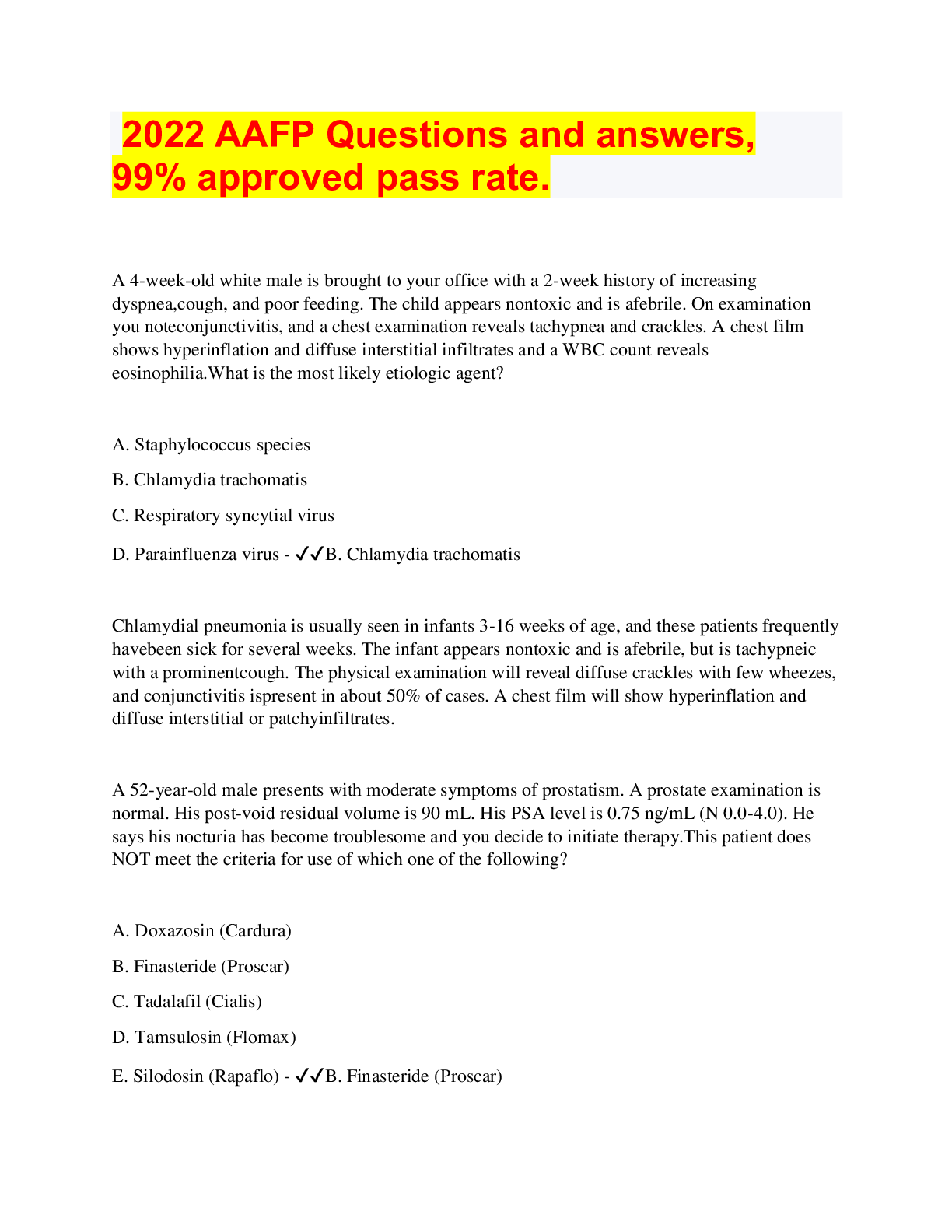
Buy this document to get the full access instantly
Instant Download Access after purchase
Add to cartInstant download
We Accept:

Also available in bundle (1)

ALL AAFP BUNDLE. LATEST VERSIONS, 2022
RATED A+ MASTERPIECES. ALL AAFPA EXAM DOCUMENTS
By bundleHub Solution guider 1 year ago
$35
10
Reviews( 0 )
$12.00
Document information
Connected school, study & course
About the document
Uploaded On
Aug 18, 2022
Number of pages
61
Written in
Additional information
This document has been written for:
Uploaded
Aug 18, 2022
Downloads
0
Views
97












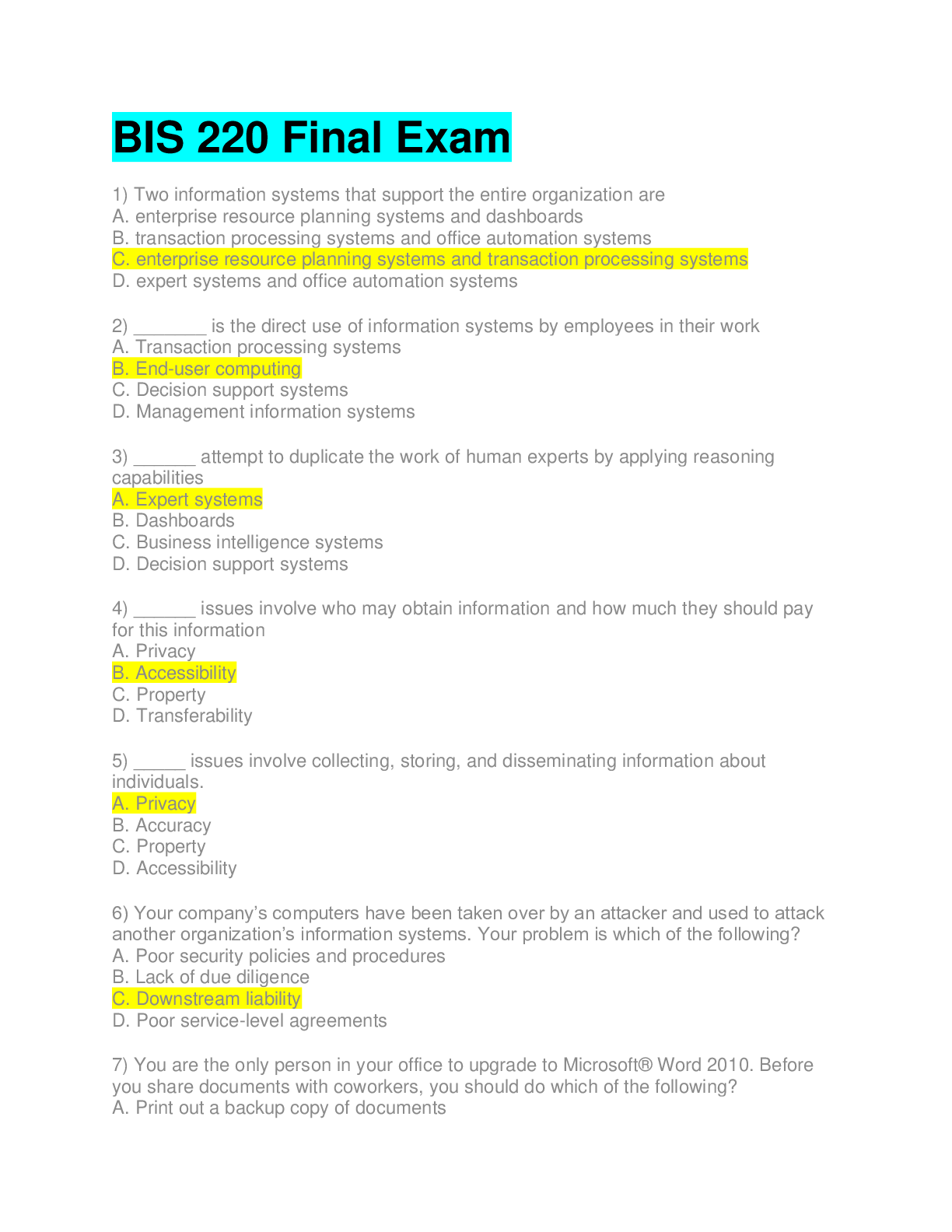

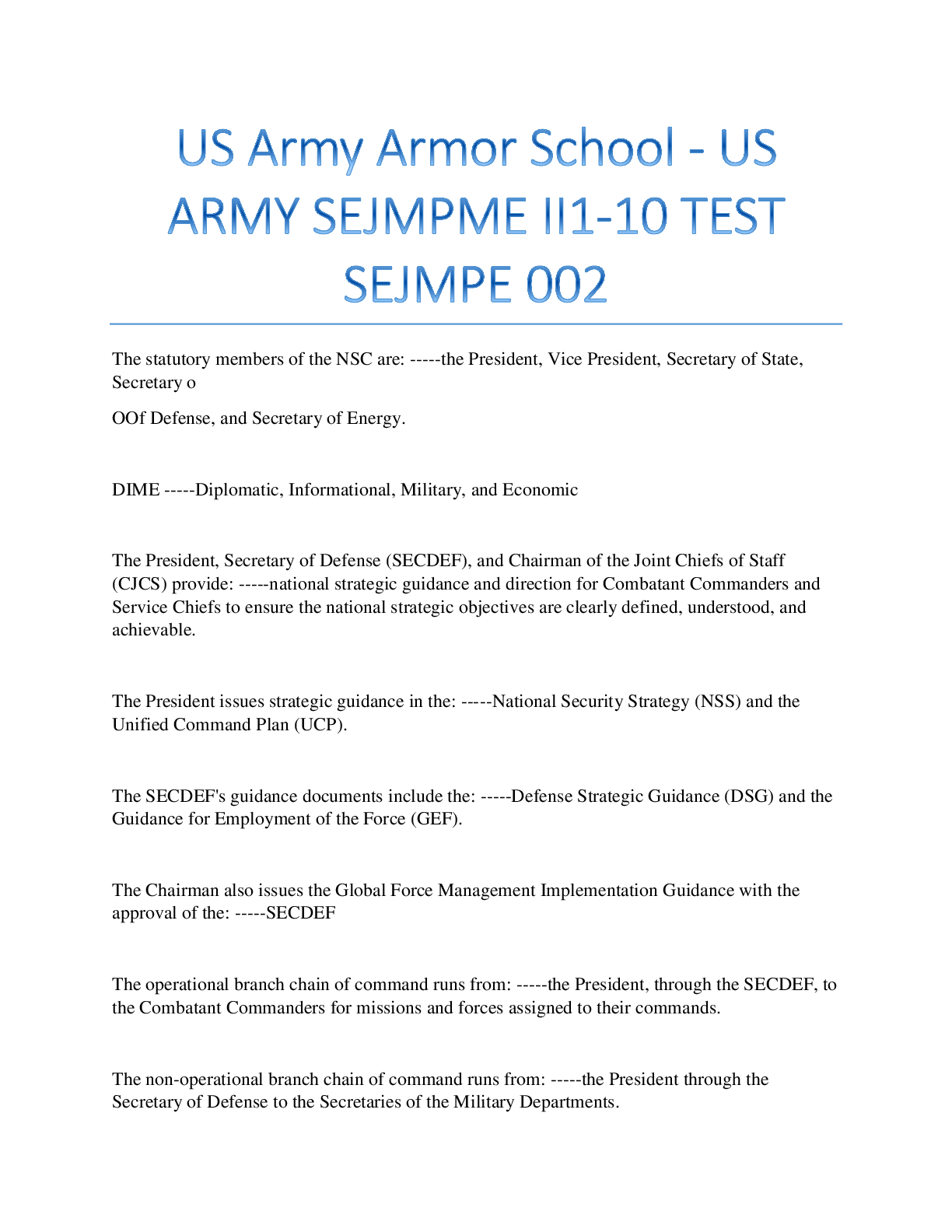



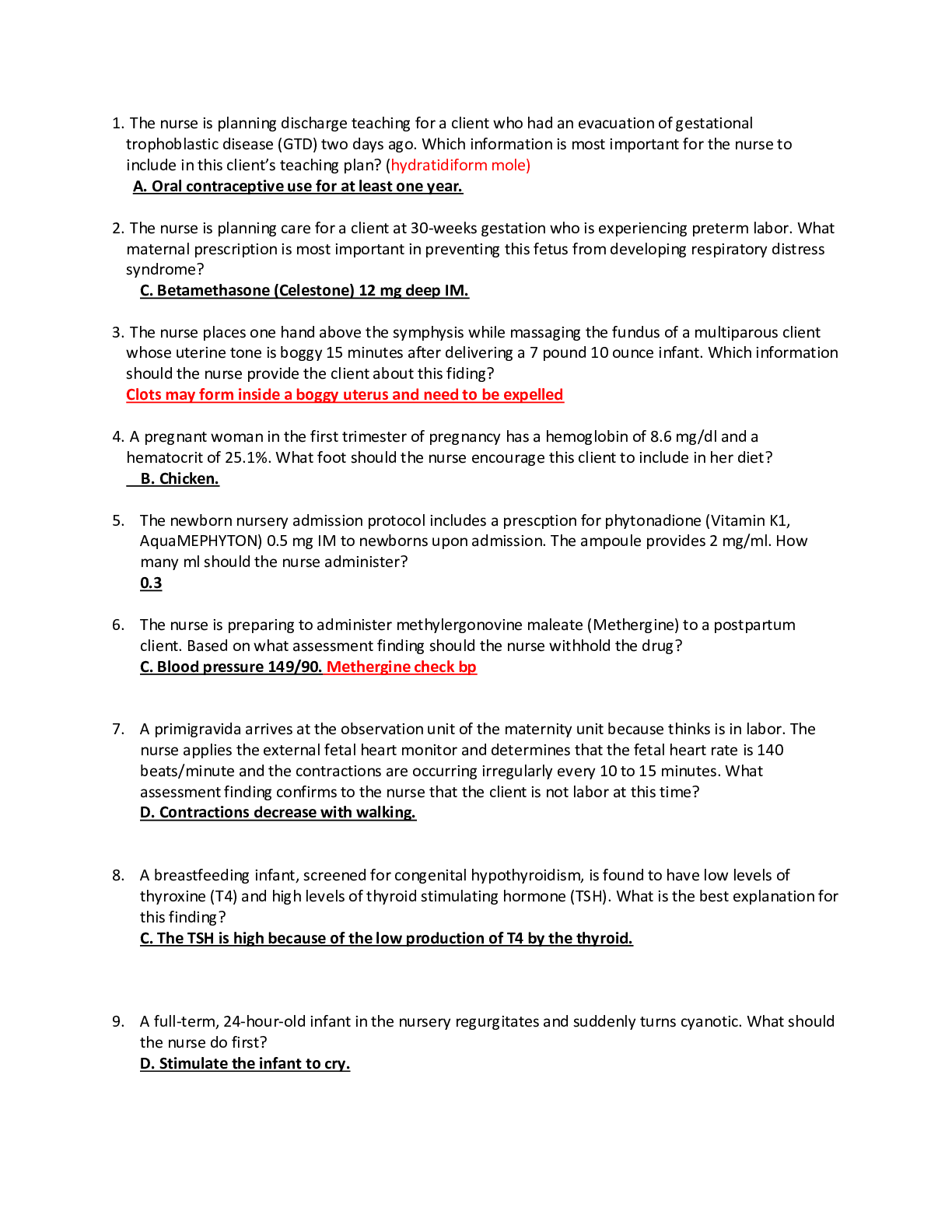
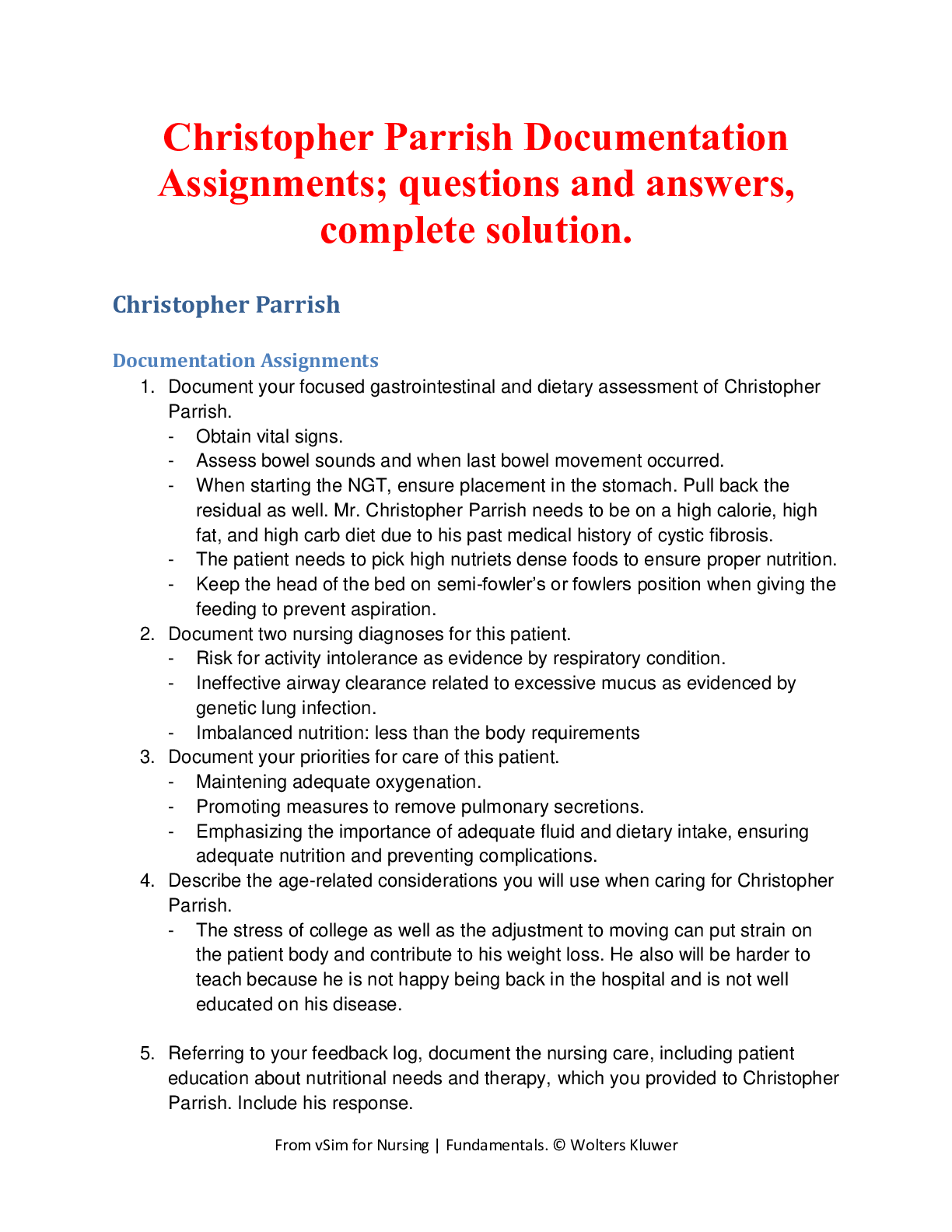
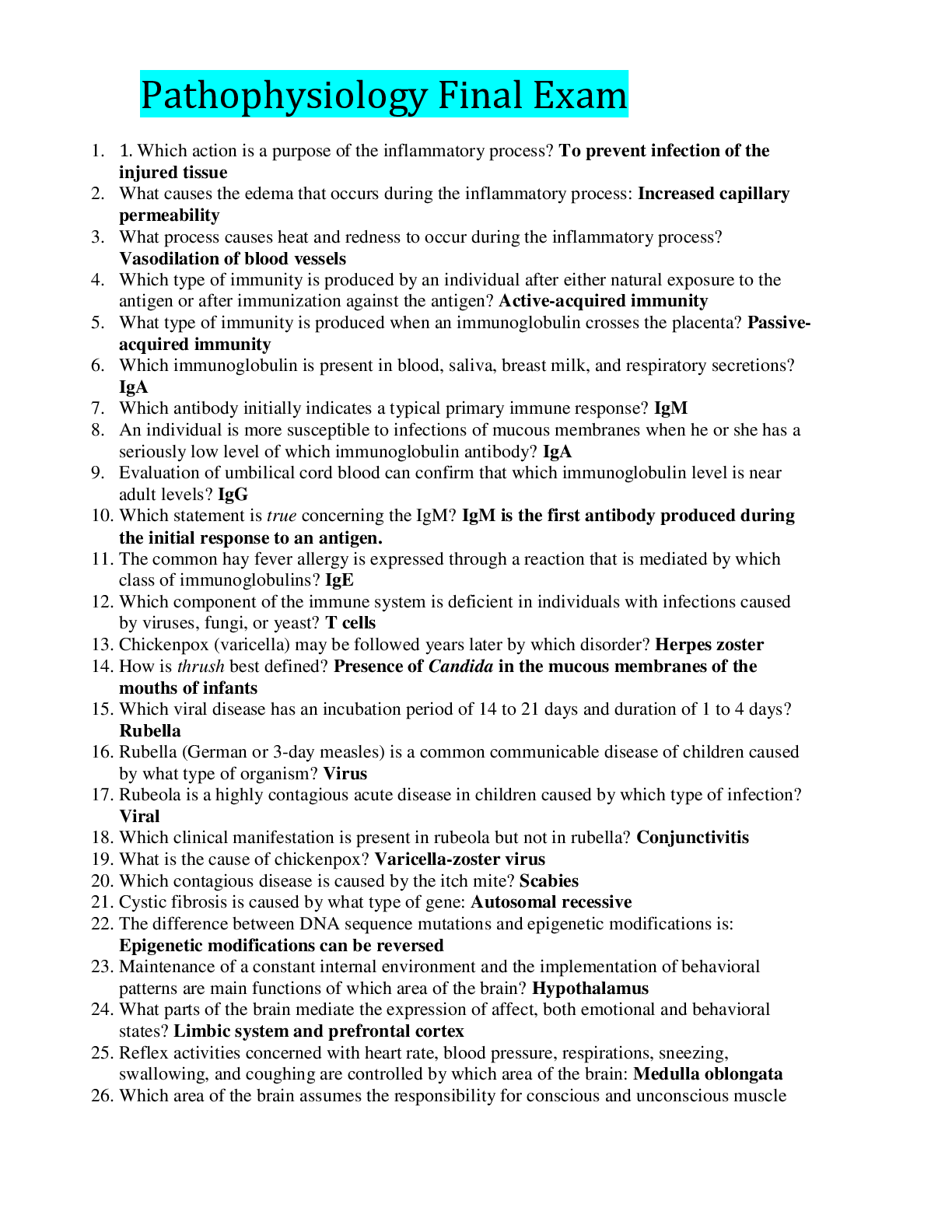
.png)



